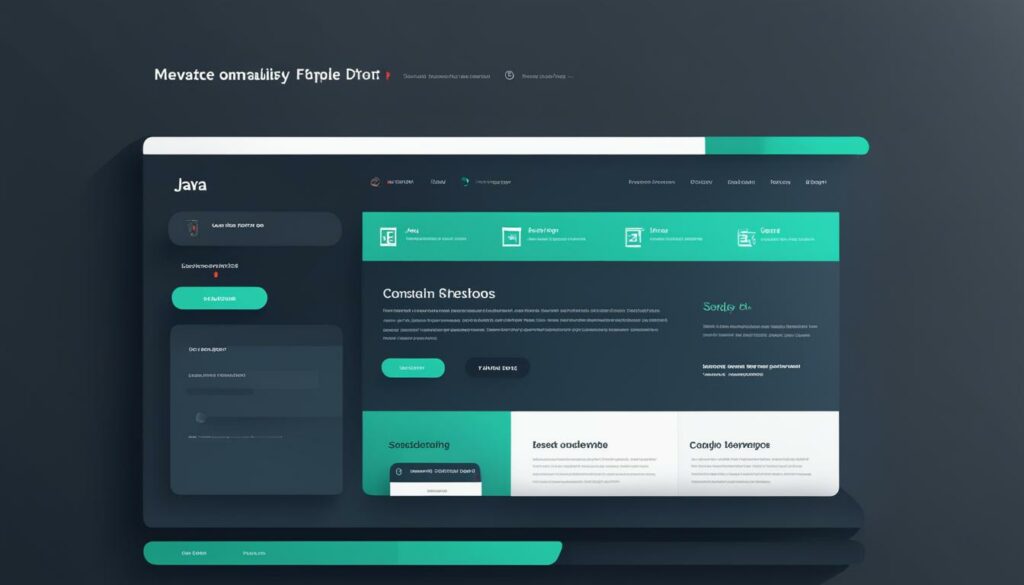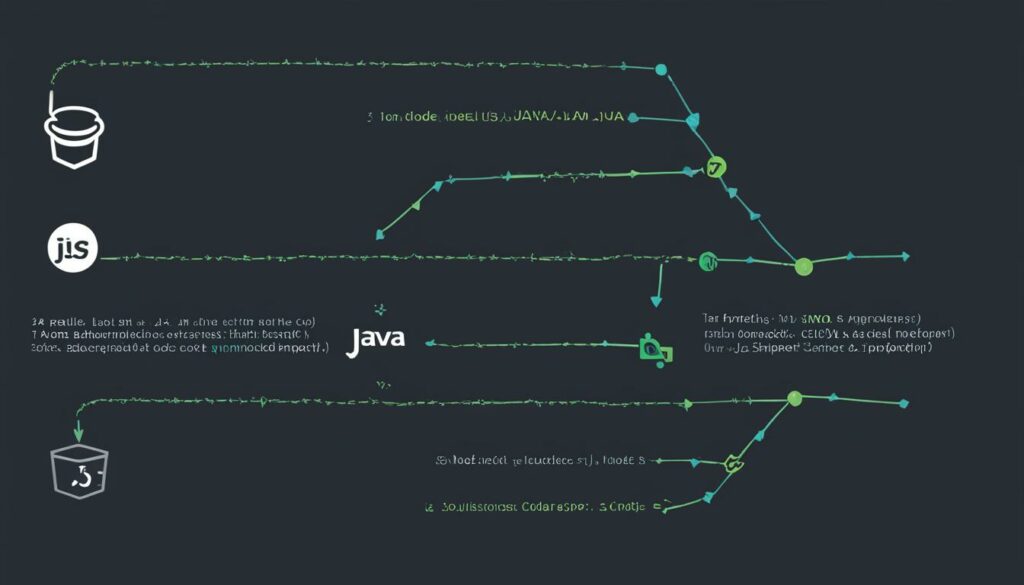Are you looking for a powerful and versatile language for web application development? Look no further than Java. With its numerous advantages and features, Java has become the go-to choice for many developers and businesses. Whether you are a small startup or a large corporation, using Java in web hosting can provide you with significant benefits.
Java-based web hosting services offer a range of advantages that make them a preferred choice for website development. Java web hosting platforms provide platform independence, allowing your applications to run on any operating system or platform with a compatible Java Virtual Machine (JVM). This means that you can reach a wider audience and ensure that your website functions seamlessly across different devices and environments.
In addition to platform independence, Java hosting solutions offer robustness and security. Java is known for its object-oriented design, automatic memory management, and robust exception handling. These features ensure that your web applications are stable, secure, and able to handle the demands of a growing user base.
Another advantage of using Java in web hosting is its high performance. Java’s Just-In-Time (JIT) compilation technique allows for efficient execution of code, resulting in faster load times and better overall performance. The language also supports multi-threading, enabling your applications to handle multiple user requests simultaneously.
When it comes to finding the best Java hosting for your websites, there are several reliable providers available. BoostedHost, for example, offers top-notch Java server hosting with excellent performance and reliability. Their Java web hosting features ensure seamless integration and provide a user-friendly experience for both developers and website visitors.
Key Takeaways:
- Java is a robust language for web application development, offering platform independence, object-oriented design, and high performance.
- Java-based web hosting services provide advantages such as security, adaptability, and scalability.
- BoostedHost offers top-notch Java server hosting for optimal performance.
- Using Java in web hosting ensures a seamless user experience and compatibility across different devices and platforms.
- Choose Java for your web development needs and unlock the full potential of your online presence.
Sign up now for BoostedHost’s recommended WordPress Hosting through this link: www.boostedhost.com/wordpress-hosting and start enjoying the benefits of using Java in web hosting.
The History of Java
In the early 1990s, James Gosling and his team at Sun Microsystems developed Java. Originally designed for embedded systems, Java quickly gained popularity as a versatile and powerful general-purpose programming language.
Java’s birth marked a significant milestone in the world of programming, as it offered a unique combination of features and capabilities. Its platform independence allowed developers to write code that ran on any operating system, making it a popular choice for cross-platform development. This contributed to its widespread adoption and the growing demand for Java in web application development.
Over the years, Java has experienced continuous development and refinement. It has evolved into one of the most widely used and respected programming languages in the industry. Its versatility and reliability have made it a go-to language for various applications, from small projects to large-scale enterprise systems.
“Java quickly gained popularity as a versatile and powerful general-purpose programming language.”
Java’s success can be attributed to its numerous advantages. Its object-oriented design enables developers to create modular and maintainable code, enhancing productivity and code reusability. Additionally, Java’s robustness and security features provide a solid foundation for building secure and reliable applications.
Java’s popularity stems from its widespread adoption and use in major companies such as LinkedIn, Uber, Microsoft, and Netflix. These industry leaders recognize the benefits of Java as a language that enables the development of scalable and adaptable web applications.
Java’s rich ecosystem, extensive libraries, and frameworks contribute to its appeal as a popular choice among developers. It has also become one of the most widely taught languages in universities and used in computer science curricula worldwide.
Key Milestones in Java’s Development
Let’s take a closer look at the key milestones in the development of Java:
- 1991: Java’s development begins at Sun Microsystems, with James Gosling leading the team.
- 1995: Java is officially released to the public.
- 1997: The Java Community Process (JCP) is established to allow community involvement in the evolution of Java.
- 2004: Sun Microsystems releases Java 5 with significant updates, including language enhancements and the introduction of generics.
- 2010: Oracle Corporation acquires Sun Microsystems and becomes the steward of Java.
- 2011: Java 7 is released, introducing new features such as the Fork/Join framework for parallel computing.
- 2014: Java 8 is released, bringing major language enhancements, including lambda expressions and the Stream API.
- 2017: Java 9 introduces module system support and improved garbage collection.
- 2020: Java 14 is released, providing new language features and improved performance.
Java’s continuous development and enhancements ensure that it remains at the forefront of modern programming languages, catering to the evolving needs of developers and users alike.
| Year | Major Release | Notable Features |
|---|---|---|
| 1995 | JDK 1.0 | Initial release of Java |
| 1996 | JDK 1.1 | Introduction of inner classes and JDBC |
| 1998 | JDK 1.2 | Enhanced GUI capabilities and collection framework |
| 2000 | JDK 1.3 | Improved performance and XML support |
| 2002 | J2SE 1.4 | Introduction of assertions and regular expressions |
| 2004 | J2SE 5.0 | Generics, enhanced for-each loop, and autoboxing |
| 2006 | Java SE 6 | Improved performance and support for dynamic languages |
| 2011 | Java SE 7 | Try-with-resources, multi-catch, and improved exception handling |
| 2014 | Java SE 8 | Lambda expressions, Stream API, and Date/Time API |
| 2017 | Java SE 9 | Module system support and improved garbage collection |
| 2020 | Java SE 14 | Text blocks, improved switch statements |
Key Characteristics of Java
Java is a powerful programming language with several key characteristics that make it a popular choice for web application development. Understanding these characteristics can help you fully appreciate the advantages and benefits that Java brings to the table. Let’s explore the key features that set Java apart:
Platform Independence
One of the standout features of Java is its platform independence. This means that Java programs can run on any platform with a compatible Java Virtual Machine (JVM). Whether you’re using Windows, Mac, Linux, or other operating systems, Java provides a seamless experience by allowing you to write code once and run it anywhere.
Object-Oriented Design
Java follows the object-oriented programming (OOP) paradigm. With OOP, developers can create modular and reusable code, resulting in more structured and maintainable applications. This design approach allows for the efficient organization of code, making development easier and accelerating the software development lifecycle.
Security and Robustness
Java is known for its robust security features, making it a trusted choice for building secure web applications. The language provides built-in security mechanisms and features like automatic memory management and strong exception management. These features contribute to the overall reliability and stability of Java applications.
High Performance
Java offers high performance through its Just-In-Time (JIT) compilation process. JIT compiles Java bytecode into machine code at runtime, optimizing the execution of code and improving overall performance. This makes Java a suitable choice for resource-intensive applications that require efficient processing and quick response times.
Adaptability and Scalability
Another noteworthy characteristic of Java is its adaptability and scalability. Java supports multi-threading, allowing applications to handle multiple tasks concurrently and effectively utilize system resources. Additionally, frameworks like Spring Boot and Vert.x provide developers with the tools and flexibility to build scalable and adaptable web applications.
Java’s platform independence, object-oriented design, security and robustness, high performance, and adaptability and scalability make it a sought-after language for web application development.
| Key Characteristics of Java |
|---|
| Platform Independence |
| Object-Oriented Design |
| Security and Robustness |
| High Performance |
| Adaptability and Scalability |
Now that you have a deeper understanding of the key characteristics of Java, you can see why it is favored by developers worldwide. These features contribute to Java’s versatility and reliability in building complex web applications.
Benefits of Using Java in Web Applications
When it comes to web application development, Java offers a wide range of benefits that make it a popular choice among developers. Let’s explore some of the key advantages:
Cross-Platform Compatibility
One of the biggest advantages of using Java in web applications is its cross-platform compatibility. Java programs can run on any operating system or platform with a compatible Java Virtual Machine (JVM). This means that your web application can reach a wider audience and be accessible to users on different devices.
Multi-Threading and Concurrency Support
Java provides excellent support for multi-threading and concurrency, allowing your web application to handle concurrent user requests efficiently. With Java’s built-in features for multi-threading, you can design responsive and scalable applications that can handle high traffic loads without slowing down.
Large Developer Community
Java has a large and active developer community, which means that you’ll have no shortage of support and resources when working with Java in your web applications. Whether you’re seeking help, looking for libraries or frameworks, or sharing your own knowledge, the Java community is always ready to assist.
Easy Integration
Another benefit of using Java is its ease of integration with various technologies. Whether you’re working with databases, web servers, or other systems, Java offers seamless integration capabilities, making it suitable for complex web application projects where multiple systems need to work together.
Long-Term Support
Java enjoys long-term support from Oracle, ensuring that you’ll receive regular updates and security patches to keep your web applications safe and up-to-date. This ensures the longevity of your projects and provides a stable foundation for your web application development endeavors.

Java has a proven track record in the world of enterprise applications. Major companies like eBay, Uber, Microsoft, and Netflix rely on Java to power their mission-critical systems. This real-world usage reinforces Java’s credibility as a reliable and scalable choice for building robust web applications.
Java Web Development Difficulties
Despite its many advantages, Java web development does come with its fair share of challenges. Here are some key difficulties you may encounter:
- Lack of Backup Facility: Unlike some other programming languages, Java does not have a built-in backup facility. This can be problematic for businesses that rely heavily on data backup and disaster recovery.
- Code Complexity: Java code can be extensive and complex, making it harder to read and maintain. As applications grow in size, managing and debugging the codebase can become increasingly challenging.
- Speed and Performance Level: While Java is known for its robustness, its interpreted nature can result in slower performance compared to native languages like C or C++. This can be a concern for applications that require real-time processing or high-speed data handling.
- Memory Capacity: Java’s memory usage may be higher compared to other languages like C and C++. This can be a limitation for applications with limited memory resources or when scaling up to handle large volumes of data.
In spite of these difficulties, Java remains a popular choice for web development due to its versatility, scalability, and extensive ecosystem of libraries and frameworks.
Top Companies That Use Java
Java is widely adopted by many major companies for various purposes in their IT stacks. Some notable examples include:
- LinkedIn: LinkedIn uses Java for search and analytics, leveraging its robust capabilities to handle large amounts of data efficiently.
- Uber: Uber relies on Java for real-time data processing, allowing them to analyze and respond to user data instantaneously.
- Microsoft: Microsoft utilizes Java for various purposes, including web browser development and backend systems for its services.
- NASA: NASA utilizes Java in the development of virtual globe software, enabling them to visualize and analyze spatial data.
- Netflix: Netflix uses Java extensively for content delivery and data analytics, allowing them to provide a seamless streaming experience to millions of users worldwide.
- Airbnb: Airbnb employs Java for building scalable and reliable backend systems, ensuring a smooth experience for their users.
- Google: Google incorporates Java in various areas, including Android app development and backend infrastructure for their services.
- eBay: eBay relies on Java for its robust and high-performance backend systems, powering its vast e-commerce platform.
- Spotify: Spotify utilizes Java in its backend infrastructure, allowing seamless music streaming and serving millions of users worldwide.
- TripAdvisor: TripAdvisor relies on Java for its backend systems, providing real-time information and reviews for travelers worldwide.
- Intel: Intel uses Java for developing enterprise-grade software solutions, benefiting from its versatility and cross-platform compatibility.
- Pinterest: Pinterest leverages Java in its backend systems, enabling users to discover and share inspiration easily.
- Groupon: Groupon utilizes Java for its backend infrastructure, supporting its extensive e-commerce platform and providing deals to customers worldwide.
- Slack: Slack employs Java for its backend services, ensuring efficient and reliable communication for teams around the world.
- Flipkart: Flipkart, one of the largest e-commerce platforms in India, relies on Java for its robust and scalable backend systems.
These are just a few examples of the top companies that rely on Java for their IT infrastructure and development needs. Java’s versatility, scalability, and extensive ecosystem make it a popular choice for industry-leading companies across various domains.

Differences Between Java Backend and Node.js Backend
When it comes to backend development, Java and Node.js are two popular choices. Each has its own strengths and advantages, making them suitable for different types of projects. Understanding the differences between Java backend and Node.js backend can help you make an informed decision about which technology to use for your specific requirements.
Java Backend
Java is a statically-typed programming language known for its performance, stability, and security features. With Java, the type of every variable is explicitly declared, allowing for better error detection at compile-time. This static typing ensures that the code is less prone to runtime errors, resulting in more reliable applications. Additionally, Java has a vast ecosystem of libraries and tools that provide robust functionality and support for various development needs.
Java’s static typing provides better performance and stability, making it a reliable choice for backend development.
Node.js Backend
Node.js, on the other hand, is a dynamically-typed runtime environment based on JavaScript. Its event-driven architecture allows handling multiple requests simultaneously, making it ideal for real-time applications such as chatbots and collaborative tools. With its non-blocking I/O model, Node.js can efficiently manage concurrent tasks and deliver responsive experiences to users. Its dynamic typing offers flexibility and quicker development cycles, allowing for rapid prototyping and iteration.
Node.js’ event-driven architecture enables efficient handling of real-time applications and concurrent user requests.
The choice between Java backend and Node.js backend ultimately depends on the specific requirements and goals of your project. If you prioritize performance, stability, and security, Java is a solid choice. On the other hand, if you are developing real-time applications and value flexibility and rapid development, Node.js may be the better option. Consider factors such as scalability, available resources, developer expertise, and project complexity when making your decision.
Comparison Table: Java Backend vs. Node.js Backend
| Java Backend | Node.js Backend |
|---|---|
| Static typing for better performance and stability | Dynamic typing for flexibility and faster development |
| Wide range of libraries and tools for extensive functionality | Event-driven architecture for efficient real-time applications |
| Strong security features | Non-blocking I/O for concurrent request handling |

As you weigh the pros and cons of Java backend and Node.js backend, it’s essential to consider your project’s specific needs and objectives. Both technologies have their own strengths and can deliver excellent results when utilized effectively. Whether you prioritize performance, stability, or real-time capabilities, make an informed decision that best aligns with your project requirements.
Top Java Frameworks for Backend Development
When it comes to backend development in Java, there are several frameworks that stand out for their features and advantages. These frameworks provide developers with the necessary tools and functionalities to build robust and scalable applications. Let’s take a closer look at some of the top Java frameworks for backend development:
1. Spring
The Spring framework is widely recognized for its dependency injection support and is known for its robustness. It offers a comprehensive ecosystem of libraries and tools that simplify backend development. With Spring, you can easily create scalable and maintainable applications.
2. Hibernate
Hibernate is an object-relational mapping (ORM) tool that simplifies database interaction in Java applications. It provides a convenient way to map Java objects to database tables, making data retrieval and manipulation seamless. Hibernate’s features include caching, lazy loading, and support for various database systems.
3. Play
Play is a highly scalable and event-driven framework that excels in building web applications. It follows the reactive programming paradigm, making it suitable for applications that require high concurrency. With Play, you can develop responsive and efficient backend systems.
4. Apache Struts
Apache Struts is a powerful framework for developing well-structured web applications. It follows the MVC (Model-View-Controller) architectural pattern, separating the presentation layer from the application logic. Struts provides features like form validation, routing, and exception handling, making it a reliable choice for backend development.
These frameworks offer a range of benefits for backend development in Java, including improved productivity, code reusability, and stability. They have extensive community support, making it easier to find resources and solutions to common problems. By leveraging these frameworks, developers can streamline the development process and deliver high-quality applications.

Best Practices For Java Web Application Development
Developing high-quality Java web applications requires adherence to best practices that encompass various aspects of the development process. From code organization and modularization to testing and quality assurance, security, continuous integration and deployment, documentation, performance optimization, error handling, and logging, following these practices ensures the creation of robust and maintainable applications.
Code Organization and Modularization
Organizing code into manageable modules promotes maintainability and reusability. Use appropriate packaging structures and apply modularization techniques such as separation of concerns and encapsulation to enhance code organization.
Testing and Quality Assurance
Conduct thorough testing to ensure the reliability, functionality, and performance of your Java web application. Implement unit tests, integration tests, and system tests to identify and rectify any issues. Incorporate continuous integration tools to automate testing and ensure continuous quality assurance.
Security Best Practices
Implement robust security measures to protect your Java web application from potential vulnerabilities. Apply authentication and authorization mechanisms, input validation techniques, and secure communication protocols. Keep your application updated with the latest security patches and regularly perform security audits.
Continuous Integration and Deployment
Utilize continuous integration and deployment tools to automate the build, test, and deployment processes. This ensures faster and more efficient development cycles, reduces errors, and enables rapid delivery of updates and enhancements.
Documentation
Create comprehensive documentation for both developers and end-users. Document the architecture, design patterns, APIs, database schema, and deployment processes to facilitate understanding and collaboration. Provide user-friendly guides and tutorials to help users navigate and utilize your Java web application effectively.
Performance Optimization
Ongoing performance optimization is crucial for delivering a responsive and efficient Java web application. Employ caching strategies, optimize database queries, minimize network overhead, and utilize performance profiling tools to identify and resolve performance bottlenecks.
Error Handling and Logging
Implement proper error handling mechanisms to gracefully handle exceptions and maintain application stability. Use logging frameworks to capture and analyze errors, allowing for effective troubleshooting and debugging.
By following these best practices, you can ensure the development of high-quality, secure, and performant Java web applications that meet the demands of your users and stakeholders.
Summary of Best Practices for Java Web Application Development
| Best Practices | Description |
|---|---|
| Code Organization and Modularization | Organize code into manageable modules, applying separation of concerns and encapsulation. |
| Testing and Quality Assurance | Conduct thorough testing and implement continuous integration tools for ongoing quality assurance. |
| Security Best Practices | Implement robust security measures, including authentication, input validation, and secure communication. |
| Continuous Integration and Deployment | Utilize continuous integration and deployment tools for automated build, test, and deployment processes. |
| Documentation | Create comprehensive documentation for developers and end-users. |
| Performance Optimization | Optimize the performance of your Java web application through caching, query optimization, and more. |
| Error Handling and Logging | Implement proper error handling mechanisms and utilize logging frameworks for effective troubleshooting. |
Conclusion
In conclusion, Java is an exceptional programming language that offers a wide range of benefits for web hosting and web application development. Its platform independence, object-oriented design, and robust security features make it a popular choice among developers. With its high performance, adaptability, and scalability, Java is well-suited for enterprise applications and can handle the demanding requirements of major companies like LinkedIn, Uber, Microsoft, and Netflix.
Java frameworks, such as Spring, Hibernate, Play, and Apache Struts, provide additional advantages and ease of development for backend applications. These frameworks offer features like dependency injection, object-relational mapping, scalability, and well-structured web application development. Additionally, by following best practices for Java web application development, developers can ensure the creation of robust, maintainable, and high-quality applications.
BoostedHost is a trusted provider of WordPress Hosting services that can optimize the performance of your Java web applications. Sign up now through this link to experience enhanced speed and reliability for your website. With BoostedHost, you can take advantage of Java’s capabilities and create a seamless online experience for your users.
FAQ
Q: What are the advantages of using Java in web hosting?
A: Java offers platform independence, object-oriented design, security, high performance, and adaptability and scalability. It is favored by many corporations and is commonly used for developing enterprise web applications. Java also has a large community, easy integration with other technologies, long-term support, and is used by major companies such as LinkedIn, Uber, Microsoft, and Netflix.
Q: What are the key characteristics of Java?
A: Java is platform independent, follows the object-oriented programming paradigm, offers security features and robust exception management, and supports high performance through JIT compilation and adaptability and scalability through multi-threading and frameworks like Spring Boot and Vert.x.
Q: What are the benefits of using Java in web applications?
A: Using Java in web applications provides cross-platform compatibility, efficient handling of concurrent user requests through multi-threading, a large and active developer community, easy integration with various technologies, long-term support from Oracle, and real-world examples of Java usage in enterprise applications.
Q: What are the difficulties in Java web development?
A: Java web development may have difficulties such as lack of a backup facility, extensive and complex code, potentially slower performance compared to native languages, and higher memory usage compared to other languages.
Q: Which top companies use Java?
A: Java is used by major companies such as LinkedIn, Uber, Microsoft, NASA, Netflix, Airbnb, Google, eBay, Spotify, TripAdvisor, Intel, and many more.
Q: What are the differences between Java backend and Node.js backend?
A: Java offers advantages like static typing, better performance and stability, and a wide range of libraries and tools. Node.js has the advantage of being dynamically-typed and is well-suited for real-time applications with its event-driven architecture.
Q: What are the top Java frameworks for backend development?
A: Some popular Java frameworks for backend development include Spring, Hibernate, Play, and Apache Struts. These frameworks provide various features and advantages for developing well-structured and scalable web applications.
Q: What are the best practices for Java web application development?
A: Best practices for Java web application development include organizing code into manageable modules, conducting thorough testing and quality assurance, implementing security measures, utilizing continuous integration and deployment tools, creating documentation, optimizing performance, and implementing proper error handling and logging.












